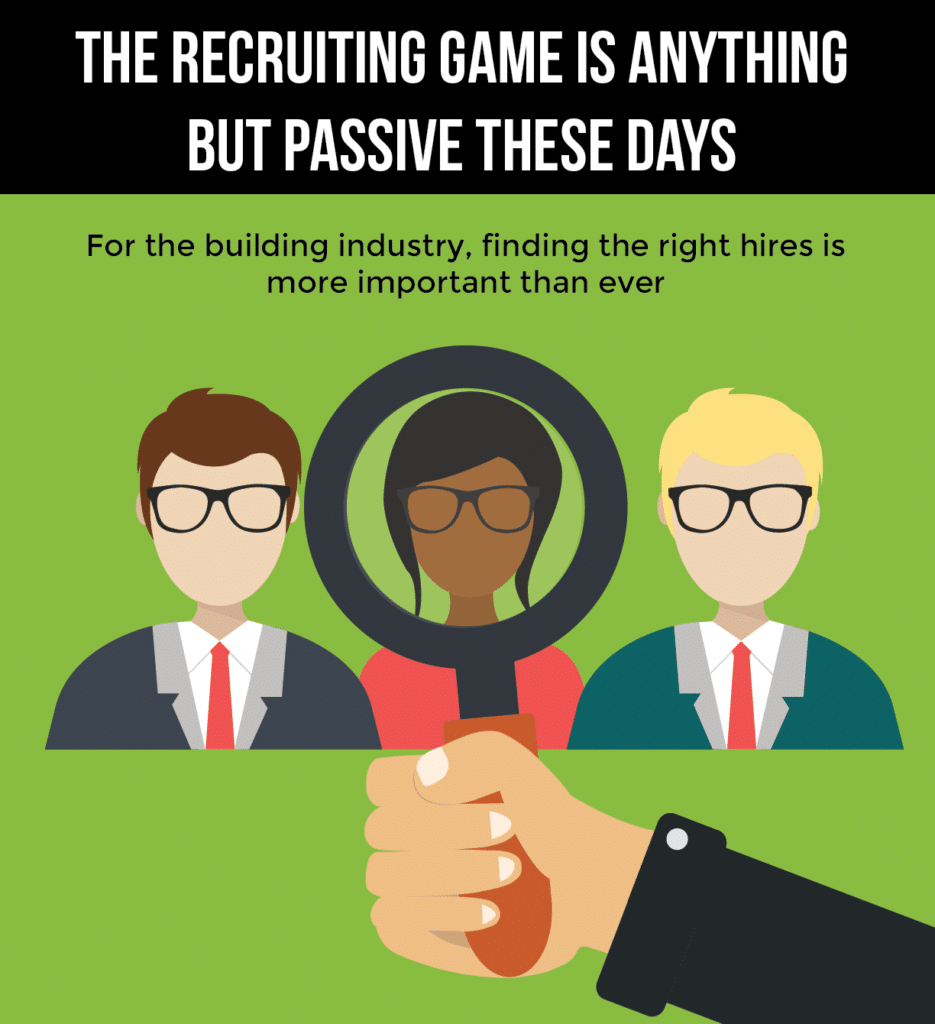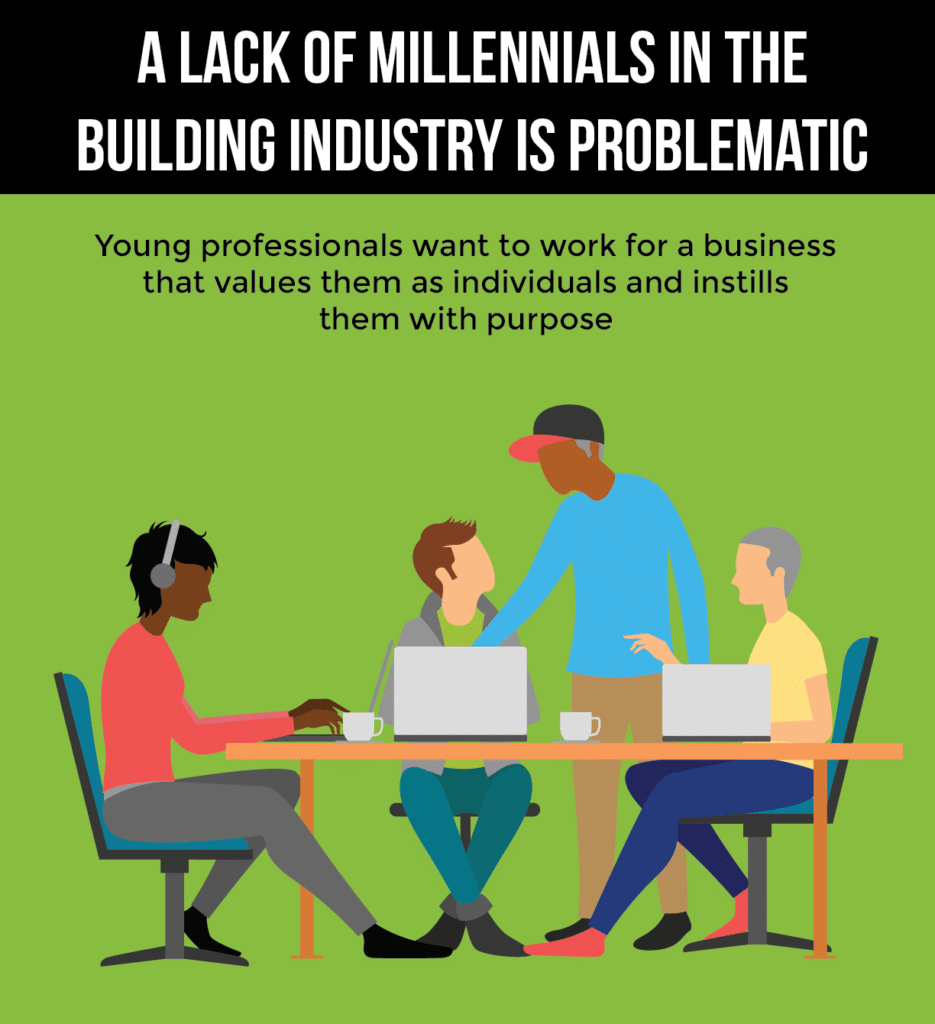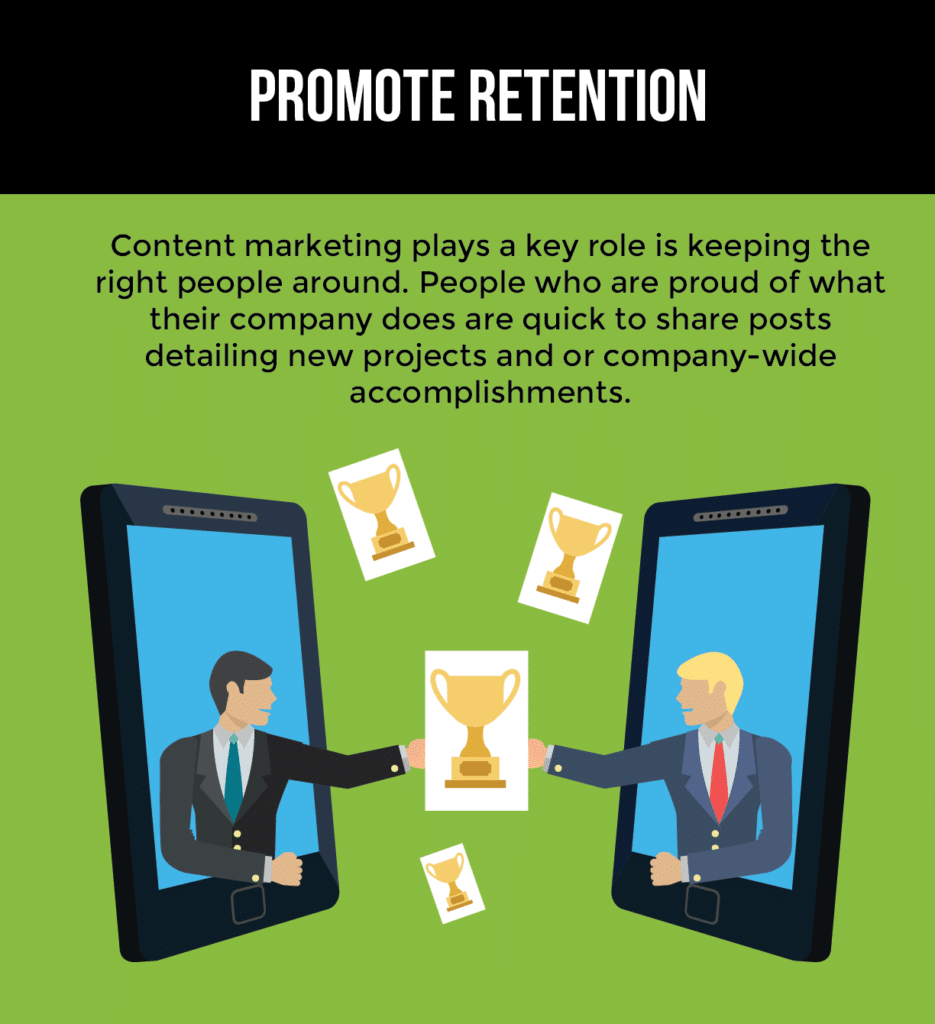The recruiting game is anything but passive these days, especially when targeting the Millenial generation to join the “less than glamorous” construction industry. All firms struggle with it, from Architects, Engineers, to Trade Contractors attempting to build their future. Understanding todays internet culture is paramount to your success in the Building Industry.

Posting an opening on a job board and waiting for candidates to apply doesn’t cut it anymore. People use job sites like Indeed to apply for openings in just a few simple clicks. Despite some filtering tools based on generic criteria, this still means hours sorting through applications… from mostly unqualified candidates.
For the building industry, finding the right hires is more important than ever. A survey conducted last year outlines the construction hiring problem:
73% of firms planned to expand their headcount in 2017 due to high demand.
Most firms actively seeking candidates reported they were having a hard time finding skilled applicants.
This hiring standoff was largely due to a skills gap in the workforce, with a particular need to find qualified workers to replace those heading for retirement.
While things may not be as grim for employee retention, the urgency to find new talent persists. The fact that a large portion of workers in the building industry are approaching retirement age exacerbates these hiring challenges. Soon there will be an even greater need for new hires in companies all across the country.
How does an industry facing these odds step up their hiring?
Companies seeking to attract qualified workers need to take an in-depth look at their current recruiting process. One promising development is Content Marketing — a marketing approach built on creating valuable and consistent content that focuses on a specific audience.
While considered an important tool in driving customers to your business, this same marketing strategy can revolutionize the way you approach recruitment.
Using content marketing to target the right candidates can provide an edge over competition in the crowded hiring space. Additional benefits include a huge cut in hiring costs and greater chance of employee retention.
In reality, the most important part of an applicant’s hiring path comes long before they fill out an application. Unless they stumbled across your company name on a job board– which again, is a big gamble in the hiring game– they most likely engaged with your content in some way.
If you’re not entirely sure what that means, take a moment to consider what someone would find by briefly searching your company name:
A robust blog with SEO friendly posts educating them on industry specific topics, or an abandoned blog with three half-hearted articles from 2014?
An Instagram account with posts that play to the platform and engage users, or an account with a few “Hire me” graphics and nothing else?
Content marketing is more than an obligatory calendar of posts and articles to share with a few sporadic followers. It’s an opportunity to establish your brand and start a conversation. Conversations to engage future customers, peers in your industry, and ideally potential hires.
If you’re ready to let content do the heavy lifting in your recruiting process, read on.
Consider the millennial market.

As more and more skilled workers reach retirement age, companies will be scrambling to find skilled workers and Project Managers. Flipping the switch on your marketing means considering this new audience and offering a take on the industry that appeals directly to them.
The first step is to recognize that when it comes to hiring, the focus has changed on both sides.
Just as hiring managers are looking beyond the resume for other signs of a good fit, candidates are vetting potential companies with a new perspective. Now workers consider factors like work/life balance, office perks, growth opportunity, and company culture when considering a new job.
Millennials, this new generation of workers, have grown up using technology to develop opinions and make decisions. They have embraced content and are constantly being influenced by it.
Young professionals want to work for a business that values them as individuals and instills them with purpose. In a recent brand study, 85% of people said that being trustworthy was the most important thing a brand can do. To build on these desires, whether it’s for new hires or new customers, you need to be authentic, consistent, and purposeful.
Your content sets those expectations.
Recruit the right people.
It’s not enough to attract candidates with your content– they need to be the right ones.
Digitalist Magazine estimated 80% of employees decide within six months whether they plan to stay with a company long-term. They found that a thorough digital onboarding process backed by strong content upped the chances of a positive decision.
High turnover is costly and has a huge effect on company morale, so retaining employees is crucial. How can you make sure your star players want to stick around?
By doing the important work before they hit “apply.”
Just as B2C marketers use content to speak directly to a customer avatar, businesses can narrow the focus of their content by speaking directly to their ideal hire. This helps to filter out applicants before they even interview. If everything you’re creating is personalized for that ideal candidate, you will get a strong response from people who see themselves in your message.
When you go to write a blog post or create an image for an Instagram ad, picture that ideal hire in your head:
Speak directly to them.
Influence their perspective of your company and its role in the industry.
Give them a glimpse of what it would mean to be part of the team.
Applicants want to be able to see themselves working for your company. Strategic content allows them to do that.
In practice, this means showcasing specifics. Give your audience the opportunity to experience what it’d be like to work at your company. Your content will not appeal to everybody, and that is fine. Specific content works as a filter to resonate with the right people who relate to your vision and your values. These are the kinds of hires that stay on and benefit the company in the long run.
Promote retention.
Even if you’re attracting long-term candidates, the work required to retain them doesn’t stop at the hiring process. Yearly raises, while appreciated, only go so far for an employee approaching their career satisfaction from multiple angles.
With the popularity of sites like Glassdoor, employee reviews of overall job satisfaction can also have a direct influence on your future hires. These live updates of how your company and your competitors are viewed by your target workforce is invaluable.
High value and often low-cost perks or a helpful list of what not to do are there for your benefit– you just need to look. Maybe you find that employees in your industry would consider community activites like “Bagel Friday” a bigger perk than that two percent raise.
Losing an employee is a stressful and expensive experience. Though it’s becoming commonplace to switch jobs multiple times over the course of a career, the building industry inspires longer stretches with one company. Content marketing plays a key role is keeping the right people around.
How do you retain employees through content? By making them advocates for your brand.
Consider LinkedIn.
An estimated 250 million users are active on the platform every month. While considered the best place to form a digital network, LinkedIn is also a content-sharing machine. People who are proud of what their company does are quick to share posts detailing new projects and or company-wide accomplishments. If you provide content that celebrates the successes of your company and employees, it will reinforce where you place your value and inspire likes, shares, and click-throughs.
Try offering surveys and other engaging content to gather valuable information for future growth initiatives. The value in this type of content goes beyond the data. Business and HR new platform Hppy expands on the emotional impact of surveys, claiming that they make current employees feel heard. Best of all, new employees see that you take action and make your staff active participants in their own career.
This transparency breeds retention and company loyalty.
Take the next steps.
We’ve established the power of content marketing when it comes to recruiting. But what does this mean for your 2018 digital marketing strategy?
Before you worry about finding an intern who can string a few posts together, consider this: more and more companies are choosing to outsource their content marketing initiatives to the experts.
Today’s audience creates personal content multiple times a day, so it makes sense they expect a greater level of professionalism and sophistication from the companies they follow. By even choosing to put content out there, you are establishing yourself as a dominant player in the industry.
Knowing how and where to access this tool is imperative to companies trying to stretch their hiring dollar. People want to trust brands, and consistent, valuable content will set your company apart from the competition. Using an agency’s understanding of SEO, industry keywords, and phrases that will trigger an emotional response from your audience can make your company a formidable expert online.
How do you find the right agency?
Thinking back to our discussion of creating content for your ideal client, and do the reverse.
You need to approach your own search in the same way your ideal hire would. Find a company that has narrowed their focus to your industry and that speaks to your company’s vision and values.
Once you’ve found a great fit, you’ll be well on your way to smarter recruiting and a stronger brand presence that attracts the right people– no endless resume sorting required.


